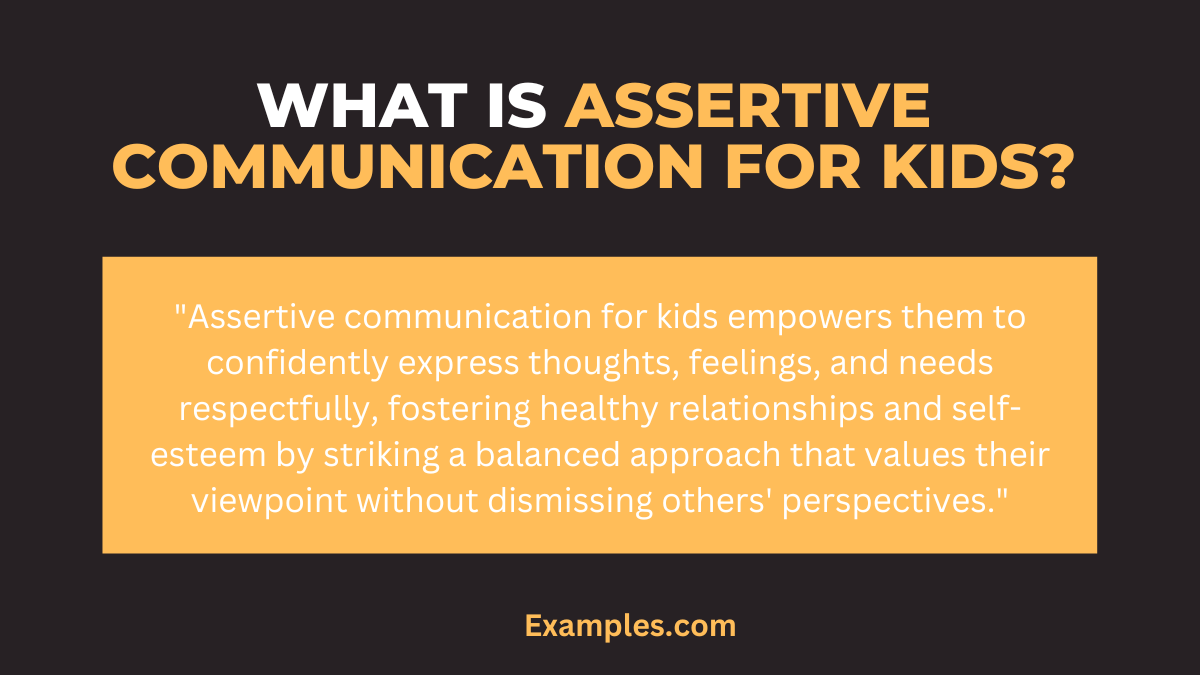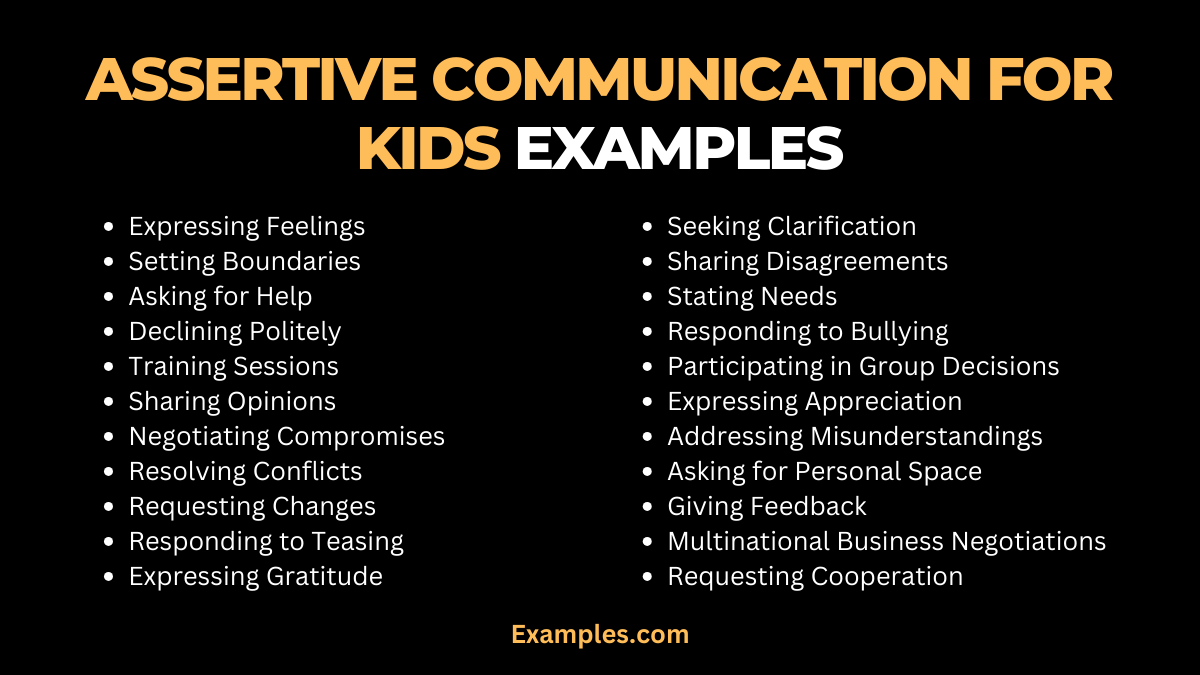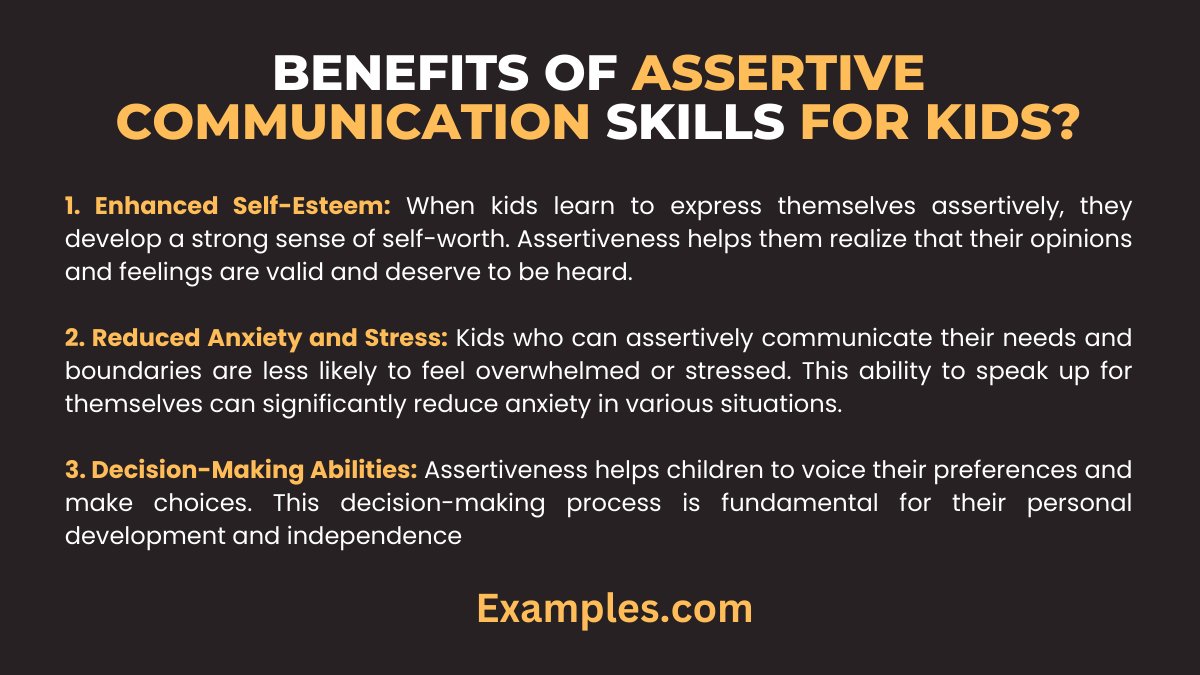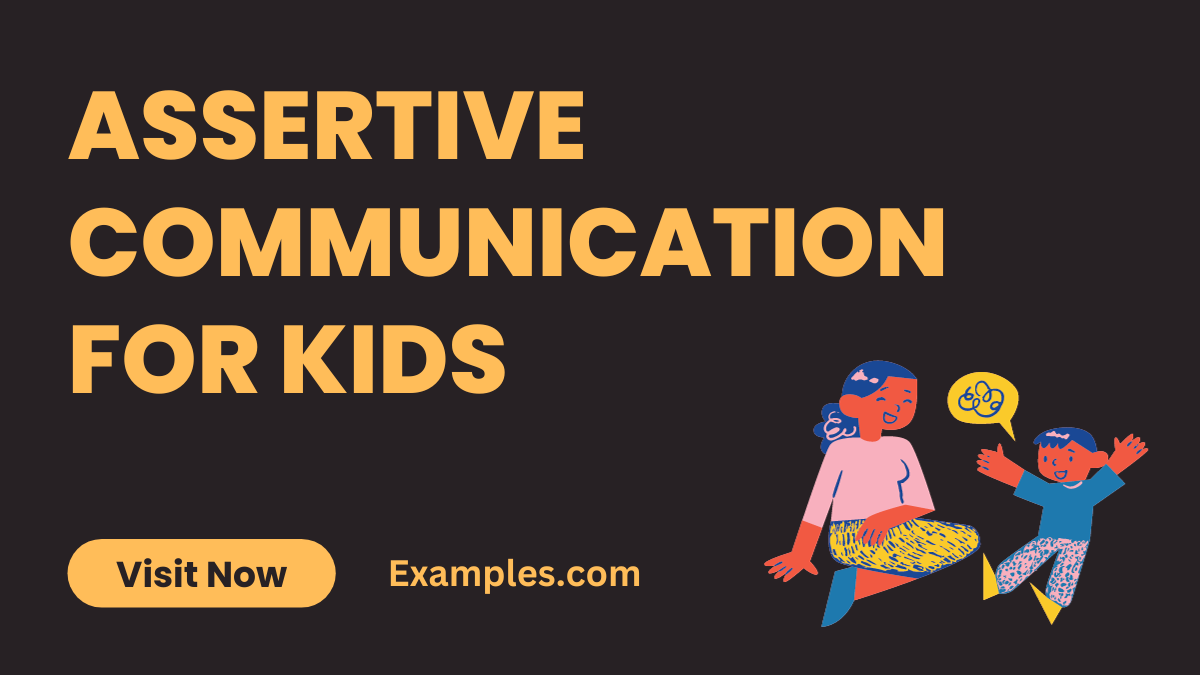19+ Assertive Communication For Kids Examples
Unlock the potential of your child’s communication skills with our complete guide on Assertive Communication for Kids. This resource is designed to empower children with effective verbal expression, promoting confidence and resilience. Explore a myriad of Communication Examples tailored for young learners, emphasizing interpersonal development. Instill vital life skills early, navigating various scenarios in school, at home, and beyond. Harness the benefits of assertive communication, fostering a positive environment for your child’s growth and social interactions.
What is Assertive Communication for Kids?

Assertive communication for kids refers to the ability of children to express their thoughts, feelings, and needs confidently and respectfully. This communication style is crucial for children as it helps them interact effectively with peers and adults, fostering healthy relationships and self-esteem. Unlike aggressive communication, which can be dominating, or passive communication, which may involve suppressing one’s voice, assertive communication strikes a balance, ensuring the child’s viewpoint is heard without disregarding others’ perspectives.
20 Assertive Communication for Kids Examples

Assertive communication for kids is an essential skill that empowers children to express their thoughts and feelings confidently and respectfully. It fosters self-esteem, improves social interactions, and teaches them to stand up for themselves in a non-confrontational manner. This skill is vital for their emotional and social development, aiding in conflict resolution and effective communication in various settings.
- Expressing Feelings: “I feel upset when you take my toys without asking. Can you please ask next time?”: Teaches children to express emotions clearly and respectfully.
- Setting Boundaries: “I don’t like it when you push me. Please stop doing that.”: Helps kids communicate personal boundaries in a direct, non-aggressive way.
- Asking for Help: “I’m having trouble with this math problem. Can you help me understand it?”: Encourages children to seek assistance confidently.
- Declining Politely: “No, thank you. I don’t want to play that game right now.”: Shows kids how to say no respectfully.
- Sharing Opinions: “I think we should play tag instead of hide and seek.”: Empowers kids to share their opinions and preferences.
- Negotiating Compromises: “Can we take turns choosing the game we play?”: Teaches the importance of compromise and negotiation.
- Resolving Conflicts: “I get upset when you call me names. Let’s find a way to play without hurting each other.”: Helps children address conflicts assertively.
- Requesting Changes: “I would like it if we could read a different story tonight.”: Encourages children to express their desires for change.
- Responding to Teasing: “I don’t like it when you make fun of me. Please stop.”: Equips kids with the language to address teasing assertively.
- Expressing Gratitude: “Thank you for helping me with my homework.”: Teaches the importance of acknowledging help and kindness.
- Seeking Clarification: “I don’t understand what you mean. Can you explain it to me?”: Encourages children to ask for more information when confused.
- Sharing Disagreements: “I don’t agree with you. I think it’s better to share our toys.”: Helps kids express disagreement in a respectful way.
- Stating Needs: “I need some quiet time now. Can we play later?”: Teaches children to communicate their needs effectively.
- Responding to Bullying: “It’s not okay to call me names. I want you to stop.”: Provides language to address bullying behavior.
- Participating in Group Decisions: “I would like to add my idea about our group project.”: Encourages involvement in group decision-making.
- Expressing Appreciation: “I really liked it when you shared your snack with me.”: Teaches children to express gratitude and appreciation.
- Addressing Misunderstandings: “I didn’t mean to break your pencil. It was an accident.”: Helps clarify misunderstandings assertively.
- Asking for Personal Space: “I’m feeling overwhelmed. I need some time alone right now.”: Teaches children to articulate their need for personal space.
- Giving Feedback: “I like playing with you when you are kind.”: Shows how to give positive feedback assertively.
- Requesting Cooperation: “Can you please lower your voice? I am trying to read.”: Helps kids ask for cooperation in a respectful manner.
Assertive Communication for Kids at School Examples
Assertive communication at school helps children express themselves confidently and respectfully in an educational environment. This skill is vital for kids to navigate school life, participate in class, and interact with peers and teachers.
- Asking for Help in Class: “Excuse me, teacher, I don’t understand this problem. Can you explain it again?” This example shows a child confidently seeking clarification without feeling embarrassed or hesitant.
- Expressing an Opinion During Discussions: “I think the story meant to teach us about teamwork. What do you all think?” This allows the child to share their perspective in a group setting respectfully.
- Responding to Bullying: “Please stop making fun of my glasses. It’s not kind.” Assertiveness here helps the child stand up for themselves against bullying.
- Negotiating with Peers: “I’ll let you use my colored pencils if you share your markers with me.” This demonstrates compromise and fair exchange among classmates.
- Participating in Group Projects: “I’m good at drawing. I can handle the poster design for our project.” Here, the child confidently offers their skills for a group task.
- Asking for a Turn: “I’ve been waiting for a while. May I have a turn on the swing now?” This teaches children to assert their right to play fairly.
- Declining Unwanted Activities: “No, thank you. I don’t want to play dodgeball today. I’d rather read.” Assertiveness allows children to refuse politely and choose activities they prefer.
- Seeking Clarification: “I didn’t hear the homework assignment. Could you repeat it, please?” This helps children ensure they have the right information.
- Expressing Discomfort: “I’m not comfortable being the class leader today. Can someone else do it?” It’s important for kids to express their comfort levels.
- Offering Ideas: “I have an idea for our class project. What if we make a model volcano?” This encourages children to contribute their ideas confidently.
Assertive Communication for Kids at Home Examples
Assertive communication at home is key for children to express their needs, feelings, and opinions within the family dynamic. It fosters independence, respect, and understanding in family relationships.
- Asking for Personal Space: “Mom, can I have some time alone in my room to read?” This helps kids express their need for privacy.
- Expressing Feelings: “Dad, I feel sad when you don’t listen to my stories.” Openly expressing emotions is a critical aspect of assertive communication.
- Negotiating Bedtime: “Can I stay up 30 minutes more if I finish all my homework?” This example shows children negotiating terms respectfully.
- Choosing Meals: “I don’t like broccoli. Can we have carrots instead tonight?” It’s important for kids to express their preferences.
- Responding to Sibling Disputes: “I don’t think it’s fair for you to use my toys without asking. Please ask next time.” This teaches respect for personal belongings.
- Asking for Help with Chores: “I’m having trouble with cleaning my room. Can someone show me how to do it better?” Children learn to seek assistance assertively.
- Declining Family Activities: “I don’t want to go biking today. I’d prefer to draw.” Kids learn to politely decline and suggest alternatives.
- Expressing Gratitude: “Thank you for helping me with my homework. I really appreciate it.” Acknowledging others’ efforts is a part of assertive communication.
- Discussing School Concerns: “I’m struggling with math and need extra help.” Kids can openly discuss academic challenges.
- Setting Boundaries with Relatives: “Uncle, I don’t like it when you tease me. Please stop.” Assertiveness helps children set personal boundaries.
How do you teach assertive communication to kids?
Teaching assertive communication to kids involves several key strategies. Start by modeling assertive behavior yourself, as children often learn by example. Use role-playing exercises to practice different scenarios, helping kids understand how to express themselves confidently and respectfully. Encourage them to use “I” statements, such as “I feel” or “I need,” to express their feelings and desires clearly. It’s also important to teach active listening skills, ensuring they understand the importance of respecting others’ viewpoints. Providing consistent feedback and positive reinforcement will help children refine their assertive communication skills over time.
What are the Benefits of Assertive Communication Skills in Kids?

Developing assertive communication skills in kids is pivotal for their holistic development. These skills enable children to express themselves clearly and confidently while respecting others’ perspectives, fostering a balanced and healthy communication style. Here are some key benefits:
- Enhanced Self-Esteem: When kids learn to express themselves assertively, they develop a strong sense of self-worth. Assertiveness helps them realize that their opinions and feelings are valid and deserve to be heard.
- Improved Social Skills: Assertive communication equips children with the ability to interact effectively with peers and adults. This leads to better relationships and a greater ability to navigate social situations, including conflict resolution and teamwork.
- Effective Conflict Resolution: Children who communicate assertively can express their needs and viewpoints without resorting to aggression or passivity. This skill is crucial in resolving disagreements and finding mutually beneficial solutions.
- Decision-Making Abilities: Assertiveness helps children to voice their preferences and make choices. This decision-making process is fundamental for their personal development and independence.
- Reduced Anxiety and Stress: Kids who can assertively communicate their needs and boundaries are less likely to feel overwhelmed or stressed. This ability to speak up for themselves can significantly reduce anxiety in various situations.
Tips for Effective Assertive Communication for Kids?
Assertive communication is an essential skill for children, equipping them with the confidence to express themselves respectfully and clearly. To foster assertive communication in kids, here are some effective tips:
- Model Assertive Behavior: Children learn by example. Demonstrate assertive communication in your interactions. Use clear, respectful language and maintain open body language.
- Encourage Open Dialogue: Create a safe space where kids feel comfortable sharing their thoughts and feelings. Encourage them to speak up about their experiences, preferences, and concerns.
- Teach the Difference Between Assertive and Aggressive Communication: Help children understand that assertiveness is about expressing oneself respectfully, not forcefully or passively. Role-play different scenarios to illustrate this difference.
- Build Emotional Vocabulary: Assist children in identifying and articulating their emotions. A rich emotional vocabulary enables them to express their feelings more clearly.
- Practice Active Listening Skills: Teach kids to listen actively and empathetically to others. This not only helps them understand different perspectives but also demonstrates respect for the speaker.
In conclusion, assertive communication is not just a skill, but a cornerstone in the development of a child’s personality and social interactions. By encouraging assertiveness, we enable our young ones to develop a balanced approach to expressing themselves, fostering not just self-esteem, but also a respectful attitude towards others. This balance is vital in helping them navigate the complexities of relationships both in their formative years and as they grow into adulthood.



